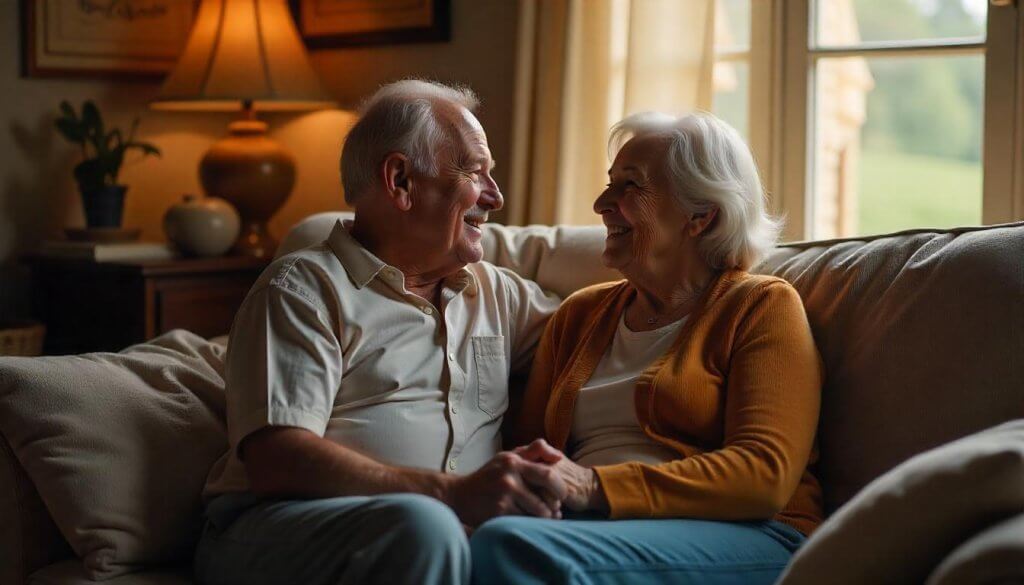Bycie dostępny emocjonalnie jest kluczem do budowania silnej i trwałej relacja. Bez tego nawet najlepsze intencje mogą prowadzić do nieporozumień, dystansu lub emocjonalnego rozłączenia. Jeśli chcesz pogłębić swoją więź ze swoim partnerNajpierw musisz nauczyć się otwierać, słuchać i odpowiadać z uwagą.
Ten przewodnik przeprowadzi Cię przez to, co to znaczy być dostępny emocjonalniejak praktykować ją codziennie i dlaczego jest ona niezbędna do osiągnięcia długoterminowego sukcesu w każdej branży. relacja.
Co to znaczy być dostępnym emocjonalnie?
Bycie dostępny emocjonalnie oznacza otwartość na odczuwanie, dzielenie się i reagowanie na emocje - zarówno własne, jak i innych osób. partnera. Wiąże się to ze szczerością, wrażliwością i chęcią bycia obecnym.
An dostępny emocjonalnie nie boi się prowadzić głębokich rozmów ani wyrażać swoich potrzeb. Nie chowa się za ciszą lub emocjonalnymi murami. Zamiast tego w pełni angażuje się w życie emocjonalne innych. relacja.
Gdy obaj partnerzy są dostępny emocjonalniew relacja staje się bezpieczną przestrzenią dla rozwoju, więzi i miłości.
Dlaczego dostępność emocjonalna ma znaczenie w związku?
Dostępność emocjonalna pomaga partnerom czuć się widzianymi, słyszanymi i rozumianymi. Pozwala na głębsze zaufanie i połączenie. Bez tego może pojawić się zamieszanie, niespełnione oczekiwania i dystans emocjonalny.
Bycie dostępny emocjonalnie konstrukcje Prawdziwe bezpieczeństwo w związku. Ty i twój partner mogą na sobie polegać nie tylko w działaniach, ale także emocjonalnie.
Emocjonalna dostępność tworzy również podstawę dla skutecznej komunikacji. Pomaga wspólnie rozwiązywać problemy i marka decyzje jako zespół.
Rozpoznawanie oznak niedostępności emocjonalnej
Zanim nauczysz się, jak być bardziej dostępny emocjonalniePomocne jest zauważenie typowych oznak niedostępności emocjonalnej:
- Unikanie poważnych rozmów
- Wyłączanie się w emocjonalnych momentach
- Trudności z wyrażaniem uczuć
- Zachowanie dystansu, gdy partner jest zdenerwowany
Jeśli te wzorce brzmią znajomo, mogą one blokować twoje relacja od rozwoju. Ale zmiana jest możliwa, gdy zdecydujesz się być obecnym i brać kroki do rozwoju emocjonalnego.
Krok 1: Najpierw bądź uczciwy wobec siebie
Samoświadomość jest pierwszym krokiem w kierunku stania się dostępny emocjonalnie. Zadaj sobie pytanie:
- Jakich emocji unikam lub tłumię?
- Czy boję się być bezbronny wobec moich partner?
- Czy reaguję lub wycofuję się, gdy sprawy stają się emocjonalne?
Rozpoznanie tych wzorców pomaga wziąć odpowiedzialność dla rozwoju emocjonalnego. Nie musisz być doskonały - wystarczy, że będziesz szczery i otwarty na zmiany.
Gdy już wiesz, od czego zaczynasz, możesz rozpocząć pracę nad tym, by stać się bardziej dostępnym w swoim życiu. relacja.
Krok 2: Znajdź czas dla swojego partnera
Aby być emocjonalnie dostępnym, musisz Znajdź czas dla swojego partnera. Oznacza to odłożenie na bok rozpraszaczy i pojawienie się z pełną uwagą.
Może to być:
- Codzienne wizyty kontrolne
- Zadawanie pytań partner jak się czują
- Słuchanie bez przerywania
- Jakość wydatków czas razem
Robiąc to regularnie, pokazujesz swoją partner że mają znaczenie. Twoje działania mówią: "Jestem tutaj i zależy mi na nich". Ponad czaswięź emocjonalna staje się głębsza.
Krok 3: Weź odpowiedzialność za swoje emocje
Część bycia dostępny emocjonalnie jest posiadanie swoich uczuć. Jeśli jesteś zły, smutny lub zestresowany, powiedz o tym. Unikaj obwiniania partner. Zamiast tego mów z własnego doświadczenia:
- "Czuję się przytłoczony" zamiast "Stresujesz mnie".
- "Potrzebuję teraz wsparcia" zamiast zamykać się w sobie.
Kiedy wziąć odpowiedzialnośćzapraszasz swoich partner aby cię wspierać, a nie bronić siebie. Otwiera to drzwi do prawdziwej więzi emocjonalnej w twoim życiu. relacja.
Krok 4: Ćwicz wrażliwość
Wrażliwość jest podstawą emocjonalnej dostępności. Oznacza pokazywanie swoich prawdziwych myśli i uczuć - nawet jeśli jest to niewygodne.
Przykłady podatności na zagrożenia w relacja:
- Przyznanie się do niepewności
- Dzielenie się obawami lub bólem z przeszłości
- Prośba o wsparcie emocjonalne
Wrażliwość buduje intymność. Kiedy ufasz swojemu partner na tyle, by się otworzyć, czują się w zamian obdarzeni zaufaniem i docenieni. To wzajemne zaufanie wzmacnia więź.
Krok 5: Słuchaj i doceniaj emocje partnera
Bycie dostępny emocjonalnie to nie tylko dzielenie się - to także słuchanie. Kiedy twój partner otwiera się, Twoim zadaniem jest pozostać obecnym i słuchać.
Nie próbuj wszystkiego naprawiać. Nie osądzaj. Po prostu słuchaj. Mów takie rzeczy jak:
- "To brzmi naprawdę ciężko".
- "Rozumiem, dlaczego tak się czujesz".
- "Jestem tu z tobą".
Sprawdzanie poprawności partnera Emocje mówią im, że nie są sami. Pokazuje, że szanujesz ich uczucia i chcesz ich wspierać.
Krok 6: Bądź konsekwentny w swoich działaniach
Dostępność emocjonalna rośnie dzięki konsekwencji. Jeśli jednego dnia pokazujesz się emocjonalnie, a następnego się wyłączasz, to partner poczują się zdezorientowani lub niebezpieczni.
Konsekwencja buduje zaufanie. Mówi ci partner"Możesz na mnie polegać".
- Bądź szczery, nawet jeśli to trudne
- Wywiązuj się ze swoich obietnic
- Regularnie sprawdzaj, jak relacja odczucia
Będąc wiarygodnym emocjonalnie, tworzysz stabilność w swoim życiu. relacja.
Krok 7: Naucz się samouspokajać i regulować swoje emocje
Bycie dostępny emocjonalnie nie oznacza bycia doskonałym. Czasami nadal będziesz czuć się zraniony, zły lub przytłoczony. Ważne jest to, jak radzisz sobie z tymi emocjami.
Nauka samouspokajania pomaga uniknąć wyładowywania swoich uczuć na innych. partner. Zapewnia również bezpieczeństwo i szacunek w rozmowach emocjonalnych.
Sposoby na samouspokojenie:
- Głębokie oddychanie
- Zapisywanie myśli w dzienniku
- Spacer lub przerwa na uspokojenie się
Ta emocjonalna kontrola sprawia, że relacja bardziej zrównoważony i pełen szacunku.
Krok 8: W razie potrzeby poszukaj pomocy
Czasami niedostępność emocjonalna jest zakorzeniona w głębszym bólu lub traumie. W takim przypadku pomocna może być terapia lub doradztwo.
Wizyta u specjalisty nie oznacza, że coś jest z tobą nie tak. Pokazuje to, że jesteś zaangażowany w rozwój - dla siebie i swojego relacja.
Może również pomóc parom, które zmagają się z emocjonalną więzią, odbudować zaufanie i intymność. czas.
Wnioski
Uczenie się, jak być dostępny emocjonalnie jest jednym z najpotężniejszych sposobów na wzmocnienie relacja. Wymaga szczerości, wrażliwości, aktywnego słuchania i konsekwentnego wsparcia.
Kiedy Znajdź czas dla swojego partnera, wziąć odpowiedzialność dla swoich emocji i pozostać otwartym, tworzysz przestrzeń dla zaufania i Prawdziwe bezpieczeństwo w związku.
Dostępność emocjonalna nie jest stałą cechą - to umiejętność, którą można budować. A kiedy zarówno ty, jak i twój partner zobowiązać się do bycia obecnym emocjonalnie relacja staje się miejscem, w którym miłość może naprawdę wzrastać.













